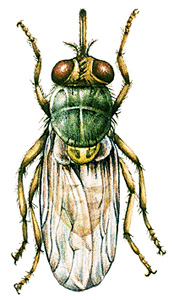Sleeping sickness is a disease that attacks the nervous system and often results in a prolonged sleep. It affects human beings and other vertebrates (animals with backbones) and is usually fatal if untreated. Sleeping sickness occurs only in Africa and is a serious health problem there for both humans and animals. Its effect on horses and cattle makes raising livestock impossible in some areas of the continent. The disease is also referred to as African sleeping sickness or African trypanosomiasis.
Cause.
Sleeping sickness is caused by several species of single-celled parasites called trypanosomes. These organisms have a wormlike shape and a whiplike extension, called a flagellum, at one end. The flagellum also extends along one side of the body to form a structure called an undulating membrane. A trypanosome moves by waving or whipping the membrane.
The trypanosomes that cause sleeping sickness in humans have the scientific names T. rhodesiense and T. gambiense. (The T. stands for Trypanosoma. ) The trypanosomes are transmitted by the tsetse fly, an insect that lives along lake shores and riverbanks in Africa. The fly becomes infected with trypanosomes while feeding on the blood of an already infected human or animal. The trypanosomes multiply in the insect’s stomach, then pass to the salivary glands. A person becomes infected when bitten by an infected fly.

Sleeping sickness in livestock results from infection by other trypanosomes, including T. brucei and T. congolense. The trypanosomes are generally transmitted by tsetse flies or other biting insects. One species is transmitted by an infected animal during mating.
Symptoms and diagnosis.
The speed at which sleeping sickness develops in people varies with the type of trypanosome involved. In general, T. rhodesiense produces symptoms that progress more rapidly than those caused by T. gambiense. Most cases of sleeping sickness begin with fever, headache, and chills. These symptoms are followed by swelling of the lymph nodes, skin rash, and weakness. In severe cases, the trypanosomes infect the central nervous system, resulting in uncontrollable sleep, coma, and death.
Doctors diagnose sleeping sickness by examining a sample of the patient’s blood, spinal fluid, or lymph. In patients who have the disease, the sample contains trypanosomes, which can be seen under a microscope. Early diagnosis of sleeping sickness is important because prompt treatment can eliminate the parasites and prevent permanent damage to nerve tissues.
Treatment and prevention.
Doctors use a variety of drugs to control sleeping sickness in people. The drug suramin is commonly given in the early stages of the disease. If treatment starts before the central nervous system becomes infected, the chances for recovery are excellent. Treatment of sleeping sickness in its later stages is less successful. In addition, trypanosomes tend to develop resistance to the drugs used.
Scientists have done much work on finding methods to control sleeping sickness and its carriers. In some parts of Africa, insecticide sprays have proved effective in eliminating tsetse fly populations. Other control efforts include the use of radiation to make male tsetse flies sterile and therefore unable to reproduce. See Tsetse fly .
